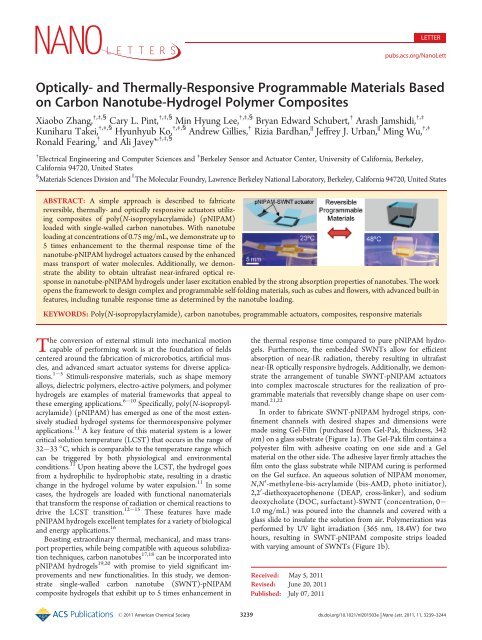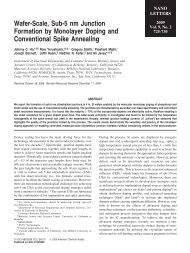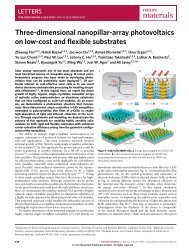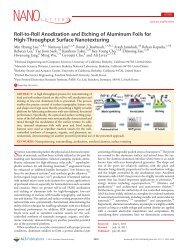Optically- and Thermally-Responsive Programmable Materials ...
Optically- and Thermally-Responsive Programmable Materials ...
Optically- and Thermally-Responsive Programmable Materials ...
You also want an ePaper? Increase the reach of your titles
YUMPU automatically turns print PDFs into web optimized ePapers that Google loves.
Received: May 5, 2011<br />
Revised: June 20, 2011<br />
Published: July 07, 2011<br />
LETTER<br />
pubs.acs.org/NanoLett<br />
<strong>Optically</strong>- <strong>and</strong> <strong>Thermally</strong>-<strong>Responsive</strong> <strong>Programmable</strong> <strong>Materials</strong> Based<br />
on Carbon Nanotube-Hydrogel Polymer Composites<br />
Xiaobo Zhang, †,‡,§ Cary L. Pint, †,‡,§ Min Hyung Lee, †,‡,§ Bryan Edward Schubert, † Arash Jamshidi, †,‡<br />
Kuniharu Takei, †,‡,§ Hyunhyub Ko, †,‡,§ Andrew Gillies, † Rizia Bardhan, || Jeffrey J. Urban, || Ming Wu, †,‡<br />
Ronald Fearing, † <strong>and</strong> Ali Javey* ,†,‡,§<br />
† ‡<br />
Electrical Engineering <strong>and</strong> Computer Sciences <strong>and</strong> Berkeley Sensor <strong>and</strong> Actuator Center, University of California, Berkeley,<br />
California 94720, United States<br />
§<br />
<strong>Materials</strong> Sciences Division <strong>and</strong> The Molecular Foundry, Lawrence Berkeley National Laboratory, Berkeley, California 94720, United States<br />
)<br />
ABSTRACT: A simple approach is described to fabricate<br />
reversible, thermally- <strong>and</strong> optically responsive actuators utilizing<br />
composites of poly(N-isopropylacrylamide) (pNIPAM)<br />
loaded with single-walled carbon nanotubes. With nanotube<br />
loading at concentrations of 0.75 mg/mL, we demonstrate up to<br />
5 times enhancement to the thermal response time of the<br />
nanotube-pNIPAM hydrogel actuators caused by the enhanced<br />
mass transport of water molecules. Additionally, we demonstrate<br />
the ability to obtain ultrafast near-infrared optical response<br />
in nanotube-pNIPAM hydrogels under laser excitation enabled by the strong absorption properties of nanotubes. The work<br />
opens the framework to design complex <strong>and</strong> programmable self-folding materials, such as cubes <strong>and</strong> flowers, with advanced built-in<br />
features, including tunable response time as determined by the nanotube loading.<br />
KEYWORDS: Poly(N-isopropylacrylamide), carbon nanotubes, programmable actuators, composites, responsive materials<br />
The conversion of external stimuli into mechanical motion<br />
capable of performing work is at the foundation of fields<br />
centered around the fabrication of microrobotics, artificial muscles,<br />
<strong>and</strong> advanced smart actuator systems for diverse applications.<br />
1 5 Stimuli-responsive materials, such as shape memory<br />
alloys, dielectric polymers, electro-active polymers, <strong>and</strong> polymer<br />
hydrogels are examples of material frameworks that appeal to<br />
these emerging applications. 6 10 Specifically, poly(N-isopropylacrylamide)<br />
(pNIPAM) has emerged as one of the most extensively<br />
studied hydrogel systems for thermoresponsive polymer<br />
applications. 11 A key feature of this material system is a lower<br />
critical solution temperature (LCST) that occurs in the range of<br />
32 33 °C, which is comparable to the temperature range which<br />
can be triggered by both physiological <strong>and</strong> environmental<br />
conditions. 11 Upon heating above the LCST, the hydrogel goes<br />
from a hydrophilic to hydrophobic state, resulting in a drastic<br />
change in the hydrogel volume by water expulsion. 11 In some<br />
cases, the hydrogels are loaded with functional nanomaterials<br />
that transform the response of radiation or chemical reactions to<br />
drive the LCST transition. 12 15 These features have made<br />
pNIPAM hydrogels excellent templates for a variety of biological<br />
<strong>and</strong> energy applications. 16<br />
Boasting extraordinary thermal, mechanical, <strong>and</strong> mass transport<br />
properties, while being compatible with aqueous solubilization<br />
techniques, carbon nanotubes 17,18 can be incorporated into<br />
pNIPAM hydrogels 19,20 with promise to yield significant improvements<br />
<strong>and</strong> new functionalities. In this study, we demonstrate<br />
single-walled carbon nanotube (SWNT)-pNIPAM<br />
composite hydrogels that exhibit up to 5 times enhancement in<br />
the thermal response time compared to pure pNIPAM hydrogels.<br />
Furthermore, the embedded SWNTs allow for efficient<br />
absorption of near-IR radiation, thereby resulting in ultrafast<br />
near-IR optically responsive hydrogels. Additionally, we demonstrate<br />
the arrangement of tunable SWNT-pNIPAM actuators<br />
into complex macroscale structures for the realization of programmable<br />
materials that reversibly change shape on user comm<strong>and</strong>.<br />
21,22<br />
In order to fabricate SWNT-pNIPAM hydrogel strips, confinement<br />
channels with desired shapes <strong>and</strong> dimensions were<br />
made using Gel-Film (purchased from Gel-Pak, thickness, 342<br />
μm) on a glass substrate (Figure 1a). The Gel-Pak film contains a<br />
polyester film with adhesive coating on one side <strong>and</strong> a Gel<br />
material on the other side. The adhesive layer firmly attaches the<br />
film onto the glass substrate while NIPAM curing is performed<br />
on the Gel surface. An aqueous solution of NIPAM monomer,<br />
N,N 0 -methylene-bis-acrylamide (bis-AMD, photo initiator),<br />
2,2 0 -diethoxyacetophenone (DEAP, cross-linker), <strong>and</strong> sodium<br />
deoxycholate (DOC, surfactant)-SWNT (concentration, 0<br />
1.0 mg/mL) was poured into the channels <strong>and</strong> covered with a<br />
glass slide to insulate the solution from air. Polymerization was<br />
performed by UV light irradiation (365 nm, 18.4W) for two<br />
hours, resulting in SWNT-pNIPAM composite strips loaded<br />
with varying amount of SWNTs (Figure 1b).<br />
r 2011 American Chemical Society 3239 dx.doi.org/10.1021/nl201503e | Nano Lett. 2011, 11, 3239–3244
Nano Letters LETTER<br />
Figure 1. SWNT-pNIPAM hydrogel fabrication <strong>and</strong> characterization. (a) Polymerization scheme for making SWNT-pNIPAM hydrogels using Gel-<br />
Pak confinement channels <strong>and</strong> UV curing. (b) Polymer strips with different SWNT concentrations made using the method shown in panel a.<br />
(c) UV vis-nIR absorption spectra of aqueous SWNT-DOC solution (blue) <strong>and</strong> a SWNT-pNIPAM hydrogel strip (SWNT concentration, 0.5 mg/mL) after<br />
polymerization (black). (d) LCST characterization for the polymer strips with different SWNT concentrations.<br />
An important consideration for high quality composites is the<br />
uniform SWNT dispersion in the p-NIPAM hydrogels. Here, we<br />
utilized an aqueous 2 wt % DOC solution as the surfactant to<br />
disperse HiPCO SWNTs (Unidym, average diameter around<br />
1.0 nm) at concentrations of up to 1 mg/mL using an ultrasonic<br />
bath. The SWNT dispersion is performed by intense sonication<br />
for at least one hour. At this stage, we except majority of the<br />
SWNTs to be open ended. Compared to other known surfactants<br />
for SWNT dispersion, such as sodium dodecyl sulfate or<br />
sodium dodecylbenzene sulfonate, we found DOC to be more<br />
stable in NIPAM monomer solutions. 23 The DOC-SWNTs <strong>and</strong><br />
NIPAM monomer solutions formed homogeneous mixtures that<br />
exhibited stability to SWNT flocculation for several weeks. The<br />
dispersion quality was characterized by absorption studies.<br />
Figure 1c shows the UV vis-nIR absorption spectra of asprepared<br />
SWNT-DOC solution <strong>and</strong> the SWNT-pNIPAM hydrogel<br />
after UV polymerization. Both samples exhibit near<br />
identical absorption spectra with the absorption b<strong>and</strong>s for the<br />
semiconductor (E 11 ∼ 870 1300 nm <strong>and</strong> E 22 ∼ 500 800 nm)<br />
<strong>and</strong> metallic SWNTs (E11 ∼ 400 600 nm) clearly distinguished,<br />
confirming the good dispersion at the concentrations studied<br />
here. 24,25<br />
To measure the LCST of the SWNT-pNIPAM hydrogels,<br />
polymer strips (50 mm 5mm 0.34 mm) with four different<br />
nanotube concentrations (0, 0.25, 0.50, <strong>and</strong> 1.0 mg/mL) were<br />
made using the aforementioned method as shown in Figure 1a.<br />
These strips were then immersed in a temperature-controlled<br />
water bath <strong>and</strong> the length of the polymer strips was measured as a<br />
function of temperature. To ensure the hydrogel is close to<br />
equilibrium, the temperature was increased in increments of<br />
1 °C, <strong>and</strong> the measurements were taken 40 min after the water<br />
had reached the target temperature. As shown in Figure 1d, the<br />
LCST temperature does not appear to be significantly influenced<br />
by the incorporation of SWNTs into the polymer hydrogels.<br />
Upon close inspection, it seems that the polymer strips with 1<br />
mg/mL SWNTs have a slight depression of the LCST 1 2 °C<br />
compared to the pure pNIPAM strips, but this depression is<br />
comparable to the expected fitting error from the measurements.<br />
Nonetheless, the fact that the LCST in the SWNT-pNIPAM<br />
composites remains well-defined suggests that the incorporation<br />
of SWNTs into the polymer hydrogel does not influence the<br />
structure <strong>and</strong> the thermally induced phase transition of the<br />
polymer strips.<br />
Next, we focus on the fabrication of thermally responsive<br />
actuator devices based on SWNT-pNIPAM composite hydrogels<br />
(Figure 2a) on low density polyethylene (LDPE, 50 μm in<br />
thickness, 16 mm 8 mm) substrates. To accomplish this, we<br />
utilized a SWNT-pNIPAM/LDPE bilayer device scheme. In this<br />
device architecture, water loss in the SWNT-pNIPAM layer<br />
results in a mechanical strain that causes the actuation of the<br />
bilayer at predefined sites. Briefly, a parallel array of 10 hinge lines<br />
(depth, ∼25 μm; width, ∼30 μm; pitch, ∼80 μm) is patterned<br />
on the LDPE substrate using a computer-controlled laser writer<br />
to define the actuation sites. Next, an array of holes (diameter,<br />
200 μm; pitch, 400 μm) are laser cut near the hinge lines in order<br />
to serve as anchoring sites for the subsequent deposition <strong>and</strong><br />
polymerization of SWNT-pNIPAM (Figure 2a). A thin layer of<br />
SWNT-pNIPAM film (∼0.4 mm thick) was then directly formed<br />
onto the anchor holes by depositing the composite solution<br />
followed by UV polymerization. This forms a hinge that can fold<br />
up to 180° due to the abrupt strain change in the polymer<br />
hydrogel above the LCST. The folding dynamics of the hinges<br />
3240 dx.doi.org/10.1021/nl201503e |Nano Lett. 2011, 11, 3239–3244
Nano Letters LETTER<br />
Figure 2. Fabrication scheme for making thermally responsive actuators <strong>and</strong> response time measurement. (a) Fabrication scheme for making SWNTpNIPAM/LDPE<br />
bilayer actuators <strong>and</strong> the corresponding optical images. (b) Response time measurement by measuring the time for the actuator to<br />
reach 90° folding angle. The inset shows an optical image of a pNIPAM/LDPE actuator before (left) <strong>and</strong> right (after) folding.<br />
Figure 3. <strong>Programmable</strong> cubes a folding cube based on thermal responsive actuators. (a) Fabrication scheme for folding cubes based on SWNTpNIPAM/LDPE<br />
bilayer actuators. (b) Cube folding by thermal actuation in 48 °C water. (c) Cube reversibly unfolds by cooling down the water bath in<br />
which cube is immersed.<br />
when transferred from a 23 to 55 °C water bath were characterized<br />
for SWNT concentrations of 0 0.75 mg/mL.<br />
The response time, corresponding to the time required to<br />
reach a folding angle of 90° is shown in Figure 2b. The response<br />
time is found to linearly change with the SWNT content for the<br />
explored concentration range (0 0.75 mg/mL) with a slope of<br />
∼ 15 s/(mg/mL). Specifically, in the case of a hydrogel with<br />
0.75 mg/mL of SWNTs, it takes ∼2.7 s for the hydrogel hinge to<br />
reach a 90° angle, compared to ∼14 s for the hydrogel without<br />
SWNTs. This leads to an overall maximum response time<br />
enhancement of ∼5 times through the incorporation of SWNTs<br />
into the polymer matrix.<br />
Considering the mechanism by which the SWNTs enhance<br />
the response time, the result could be related to either one of two<br />
possible mechanisms: (i) enhancement of polymer composite<br />
thermal conductivity yielding faster heat transfer through the<br />
hydrogel, or (ii) enhancement of the mass (water) transport<br />
through the hydrogel due to the integration of SWNT fluidic<br />
channels in the hydrogel structure. 26,27 If we assume the thermal<br />
conductivity of pNIPAM hydrogel is equal to the thermal<br />
conductivity of water, simple heat transport modeling 28 reveals<br />
that the inner temperature of the hydrogel reaches the temperature<br />
of the hot water (55 °C) from an initial state of 25 °C in less<br />
than a second for the specific device dimensions explored here.<br />
Thereby, the response time is not limited by the heat transport<br />
since the time scale on which variations in thermal conductivity<br />
will influence the SWNT-pNIPAM response is significantly less<br />
than the actuator response time. Therefore, we propose the<br />
3241 dx.doi.org/10.1021/nl201503e |Nano Lett. 2011, 11, 3239–3244
Nano Letters LETTER<br />
Figure 4. <strong>Programmable</strong> “flower’ made by heterogeneous integration of pNIPAM <strong>and</strong> SWNT-pNIPAM bilayer actuators. (a) Fabrication scheme for<br />
making a programmable flower, consisting of two layers of actuators. (b) Flower folding (i.e., closes) when heated in a water bath to 50 °C. (c) Flower<br />
blooming by cooling down the water bath.<br />
Figure 5. Near-IR optical response measurement for SWNT-pNIPAM hydrogels. (a) SWNT-pNIPAM/LDPE bilayer actuator (note: the background<br />
features are the hinge lines). (b d) SWNT-pNIPAM hydrogel turns opaque (i.e., black) after illuminated by the near-IR laser beam from the top due to<br />
the shrinking of the SWNT-pNIPAM layer. (e h) SWNT-pNIPAM hydrogel turns transparent after the laser beam is turned off which indicates the<br />
transition of the hydrogel back to a swelled state.<br />
response time is instead limited by the mass transport of water<br />
<strong>and</strong> by the polymer chain reorganization (from hydrophilic to<br />
hydrophobic). 29 The addition of SWNTs into the pNIPAM<br />
hydrogel provides more porous (nano or microscale pores<br />
between pNIPAM <strong>and</strong> SWNTs) structures for enhanced water<br />
diffusion. In addition, previous reports have shown that carbon<br />
nanotubes can act as efficient channels for water flow driven by<br />
the osmotic pressure. Molecular dynamics simulation has shown<br />
that the flow rate can be as high as 5.8 molecules per nanosecond<br />
per nanotube <strong>and</strong> almost friction-less. 27 The diffusion coefficient<br />
of a hydrogel has been shown to be inversely proportional to the<br />
diffusion friction coefficient between the fluid <strong>and</strong> the network<br />
3242 dx.doi.org/10.1021/nl201503e |Nano Lett. 2011, 11, 3239–3244
Nano Letters LETTER<br />
which can be effectively reduced by adding of SWNT as shown<br />
here. 30<br />
We now demonstrate the ability to make “smart” or programmable<br />
devices based on the integration of SWNT-pNIPAM<br />
(0.5 mg/mL) hydrogel hinges arranged in complex assemblies.<br />
Shown in Figure 3a is the schematic of a cube fabricated using<br />
the concept of bilayer hinges (Figure 2a) made of SWNTpNIPAM<br />
hydrogels. The cube template was fabricated on a laser<br />
patterned 50 μm LDPE film followed by the UV polymerization<br />
of SWNT-pNIPAM hydrogel patches on the hinges. When<br />
placed in warm water (48 °C), the strain induced by the shrinking<br />
hydrogel patches causes the cooperative folding of each hinge<br />
until the equilibrium shape of a cube is obtained. Figure 3a<br />
illustrates this process with a scheme, <strong>and</strong> Figure 3b,c shows that<br />
optical images of the cube folding <strong>and</strong> unfolding in a water bath<br />
after being heated to 48 °C, <strong>and</strong> subsequently cooled to 20 °C,<br />
respectively. In this case, the entire process of cube folding takes<br />
∼35 s, which is significantly faster than a similar device with only<br />
pNIPAM hydrogel hinges that would take up to ∼150 s to<br />
perform the same function. The process is reversible <strong>and</strong> the<br />
closed cube can unfold completely when cooled down in water.<br />
In addition to complex SWNT-pNIPAM hydrogel assemblies<br />
composed of only one type of hydrogel, we also demonstrate the<br />
ability to exploit the response time enhancement in the SWNTpNIPAM<br />
hydrogels in the framework of a multilayer actuator<br />
architecture. Shown in Figure 4a is a design scheme for a<br />
multilayered patterned hinge resembling a flower, where the<br />
first layer of hinges are designed with a pNIPAM hydrogel<br />
(i.e., without SWNTs), whereas the second layer of hinges are<br />
composed of a SWNT-pNIPAM hydrogel that exhibits significantly<br />
enhanced response time. This allows the actuator device to<br />
exhibit an additional level of complexity that resembles the<br />
closing or blossoming of a real flower that has some leaves<br />
closing (blooming) earlier than others. Figure 4b shows a frame<br />
shot of this complex flower that is taken after the flower is placed<br />
in warm water (48 °C). In this case, even after 10 s of being<br />
immersed in the warm water, the hinges with the SWNTpNIPAM<br />
have already reached a folding angle of over 90°,<br />
whereas the hinges with only pNIPAM hydrogels remain only<br />
slightly bent (
Nano Letters LETTER<br />
(9) Zhang, Q. M.; Li, H.; Poh, M.; Xia, F.; Cheng, Z. Y.; Xu, H.;<br />
Huang, C. Nature 2002, 419, 284–287.<br />
(10) Yerushalmi, R.; Scherz, A.; van der Boom, M. E.; Kraatz, H. B.<br />
J. Mater. Chem. 2005, 15, 4480–4487.<br />
(11) (a) Schild, H. G. Prog. Polym. Sci. 1992, 17, 163–249. (b) Liang,<br />
L.; Feng, X.; Liu, J.; Rieke, P. C.; Fryxell, G. E. Macromolecules 1998,<br />
31, 7845–7850. (c) Rzaev, Z. M.O.; Dincer, S.; Piskin, E. Prog. Polym. Sci.<br />
2007, 32, 534–595.<br />
(12) Miyako, E.; Nagata, H.; Hirano, K.; Hirotsu, T. Small 2008,<br />
4, 1711–1715.<br />
(13) Hendrickson, G. R.; Smith, M. H.; South, A. B.; Lyon, L. A. Adv.<br />
Funct. Mater. 2010, 20, 1697–1712.<br />
(14) Fujigaya, T.; Morimoto, T.; Niidome, Y.; Nakashima, N. Adv.<br />
Mater. 2008, 20, 3610–3614.<br />
(15) Tokarev, I.; Minko, S. Soft Matter 2009, 5, 511–524.<br />
(16) Kim, J.; Yoon, J.; Hayward, R. C. Nat. Mater. 2010, 9, 159–164.<br />
(17) Javey, A. ACS Nano 2008, 2, 1329–1335.<br />
(18) Dai, H. Surf. Sci. 2002, 500, 218–241.<br />
(19) Fujigaya, T.; Morimoto, T.; Niidome, Y.; Nakashima, N. Adv.<br />
Mater. 2008, 20, 3610–3614.<br />
(20) Wang, D.; Chen, L. Nano Lett. 2007, 7, 1480–1484.<br />
(21) Maeda, S.; Hara, Y.; Sakai, T.; Yoshida, R.; Hashimoto, S. Adv.<br />
Mater. 2007, 19, 3480–3484.<br />
(22) Cho, J. H.; Datta, D.; Park, S. Y.; Shenoy, V. B.; Gracias, D. H.<br />
Nano Lett. 2010, 10, 5098–5102.<br />
(23) Kocharova, N.; Aaritalo, T.; Leiro, J.; Kankare, J.; Lukkari, J.<br />
Langmuir 2007, 23, 3363–3371.<br />
(24) Weisman, R. B.; Smalley, R. E. Science 2002, 297, 593–596.<br />
(25) Hauge, R. H.; Smalley, R. E.; Weisman, R. B. Science 2002,<br />
298, 2361–2366.<br />
(26) Kalra, A.; Garde, S.; Hummer, G. Proc. Natl. Acad. Sci. U.S.A.<br />
2003, 100, 10175–10180.<br />
(27) Joseph, S.; Aluru, N. R. Nano Lett. 2008, 8, 452–458.<br />
(28) Widder, D. V. The Heat Equation; Academic Press, Inc.: New<br />
York, 1975.<br />
(29) Okano, T.; Bae, Y. H.; Jacobs, H.; Kim, S. W. J. Controlled<br />
Release 1990, 11, 255–265.<br />
(30) Li, Y.; Tanaka, T. J. Chem. Phys. 1990, 92, 1365–1371.<br />
(31) Morimoto, M.; Irie, M. J. Am. Chem. Soc. 2010, 132,<br />
14172–14178.<br />
(32) Van Oosten, C. L.; Bastiaansen, C. W. M.; Broer, D. J. Nat.<br />
Mater. 2009, 8, 677–682.<br />
3244 dx.doi.org/10.1021/nl201503e |Nano Lett. 2011, 11, 3239–3244







